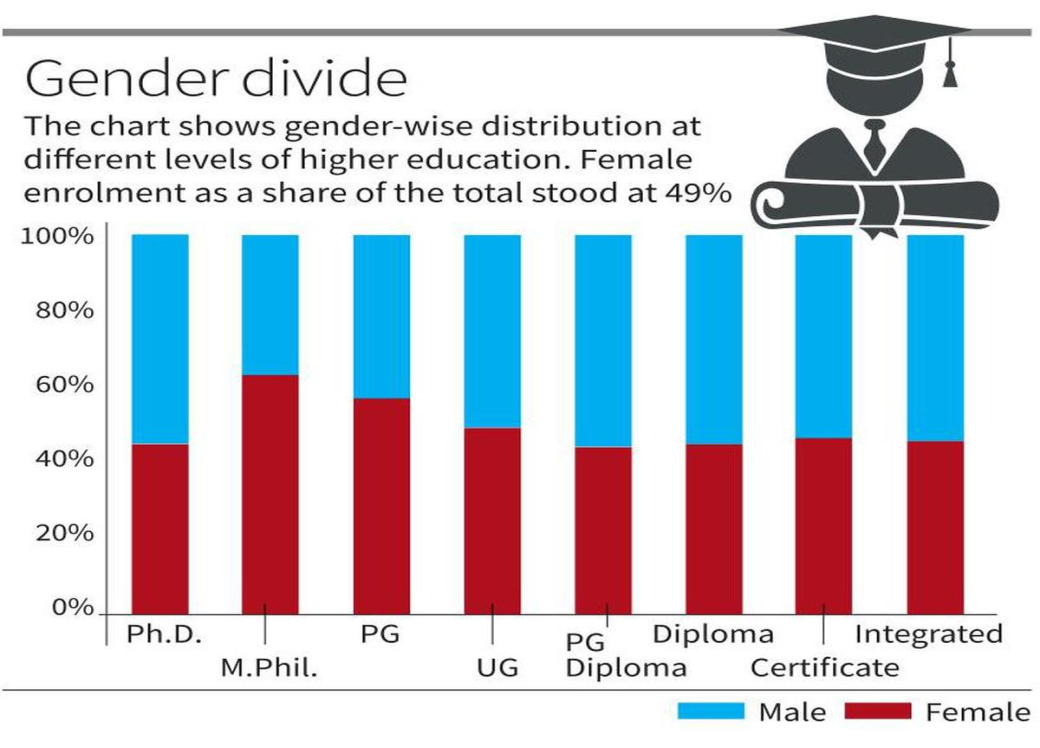Description

Copyright infringement not intended
About:
- The Union Ministry of Education has released the All India Survey on Higher Education (AISHE) 2020-2021.
- The Ministry has been conducting the Survey since 2011, it covers higher educational institutions located in India.
- The survey collects information on different parameters such as student enrollment, teacher data, infrastructural information, financial information etc.
- In AISHE 2020-21, for the first time, the data was filled in using an entirely online data collection platform developed by the Department of Higher Education through the National Informatics Centre (NIC).
Key highlights of the survey:
- In higher education, the total enrollment has increased to nearly 4.14 crore in 2020-21 from 3.85 crores in 2019-20.
- Female enrolment has increased to 2.01 crore from 1.88 crores in 2019-20.
- Gross Enrolment Ratio (GER) for the 18-23 years age group has increased to 27.3 % from 25.6 % in 2019-20.
- Gender Parity Index (GPI), the ratio of female GER to male GER, has increased from 1 in 2017-18 to 1.05 in 2020-21.
- The female enrolment in North East States is 6.14 lakh in 2020-21, higher than the male enrolment of 5.92 lahks, For every 100 male students, there are 104 female students in North East Region.
- The enrolment in Distance Education is 45.71 Lakh, an increase of around 7% since 2019-20.
- Top 6 states in terms of the number of students enrolled; Uttar Pradesh, Maharashtra, Tamil Nadu, Madhya Pradesh, Karnataka and Rajasthan.
- About 79.06% of the total students are enrolled in undergraduate-level courses and 11.5% are enrolled in postgraduate-level courses.
- Among Disciplines at the undergraduate level, enrollment is highest in Arts (33.5%), followed by Science (15.5%), Commerce (13.9%) and Engineering & Technology (11.9%).
- Among streams at the postgraduate level, the maximum number of students are enrolled in Social Science (20.56%) followed by science (14.83%).
- The total number of pass-outs has increased to 95.4 Lakh in 2020-21 as against 94 Lakh in 2019-20.
- Availability of infrastructural facilities in HEIs in 2020-21:
- Libraries in 97%
- Laboratories in 88%
- Computer centres in 91%.
- Skill Development Centre in 61%.
- Connectivity to National Knowledge Network in 56%.
- During 2020-21, the number of Universities has increased by 70, and the number of Colleges has increased by 1,453.
- Since 2014-15, an increase of 353 Universities (46.4%).
- The Institutes of National Importance (INIs) have increased from 75 in 2014-15 to 149 in 2020-21.
- The highest number of Universities is in Rajasthan (92), Uttar Pradesh (84) and Gujarat (83).
- The College Density, the number of colleges per lakh eligible population (population in the age group 18-23 years) has been 31. This was 27 in 2014-15.
- States with the Highest college density: Karnataka (62), Telangana (53), Kerala (50), and Himachal Pradesh (50).
- Top 8 Districts with the Highest number of Colleges: Bangalore Urban (1058), Jaipur (671), Hyderabad (488).
- The top States in terms of the number of colleges: are Uttar Pradesh, Maharashtra, Karnataka, Rajasthan, and Tamil Nadu.
- 43% of universities and 61.4% of colleges are located in Rural Areas.
- Faculty/teachers; about 57.1% are male and 42.9% are female.
.jpeg)
Challenges in Indian Education System:
- India has achieved universal enrolment at the elementary level. This is a great achievement, but getting Students to School is only the beginning of human Capital formation.
- Poor quality of facilities, Shortage of qualified faculty.
- Date Curriculum, Limited university-industry Partnership.
- Indian origin Scientists have won the Nobel Prize, but post-independence work done in India has not led to a Science novel. If Indians Studying and working abroad can have a great impact, then obviously the problem has to do with our Systems of education and research.
- Broken Governance System. There are few rewards for being a good teacher and few Punishments for being a Careless one. Need more effective and accountable governance Systems.
- The greed of Private Colleges to earn the maximum from every Student puts traumatic Pressure on Students which results in mental breakdown.
- More girls than boys drop out of School. While boys drop out to work, girls usually Stay at home and help with domestic Work. Social Conception of gender roles is an important factor.
- Learning loss due to pandemics and the digital divide.
Steps by the Government:
- The 86th Constitution Amendment provides the Fundamental right to free and compulsory education under Article 21A includes a Common education System where the “rich and Poor are educated under one roof".
- Rashtriya Uchchatar Shiksha Abhiyan provides funding to eligible State higher educational institutions.
- Declaration of Educational Institutions as institutions of Eminence, to provide world-class education to Indian Students within the Country.
- Creation of Higher Education Financing Agency, for high-quality infrastructure in Premier educational institutions.
- National Institution Ranking Framework for ranking our higher education institutions.
- GIAN Initiative invites distinguished academicians, entrepreneurs, scientists, and experts from premier institutions across the world to teach in higher educational institutions in India.
- SWAYAM Portal for Online Courses.
- SWAYAM Prabha Provide HD educational Channels through DTH on a 24X7 basis.
- Sodhganga to develop a national repository of universities in India, digital Study material for higher education.
- Samagra Shiksha Scheme to ensure inclusive and equitable quality education at all levels of school education.
- The government is encouraging Open Online Courses via Swayam Platforms So that Students Can have access to quality lectures online.
- Artificial Intelligence (AI) can be used to Provide Personalized instructions based on Student needs.
- The government needs to work on improving digital infrastructure and ensure that students have access to mobile phones or laptops.

https://indianexpress.com/article/explained/beating-retreat-2023-history-significance-8410907/













